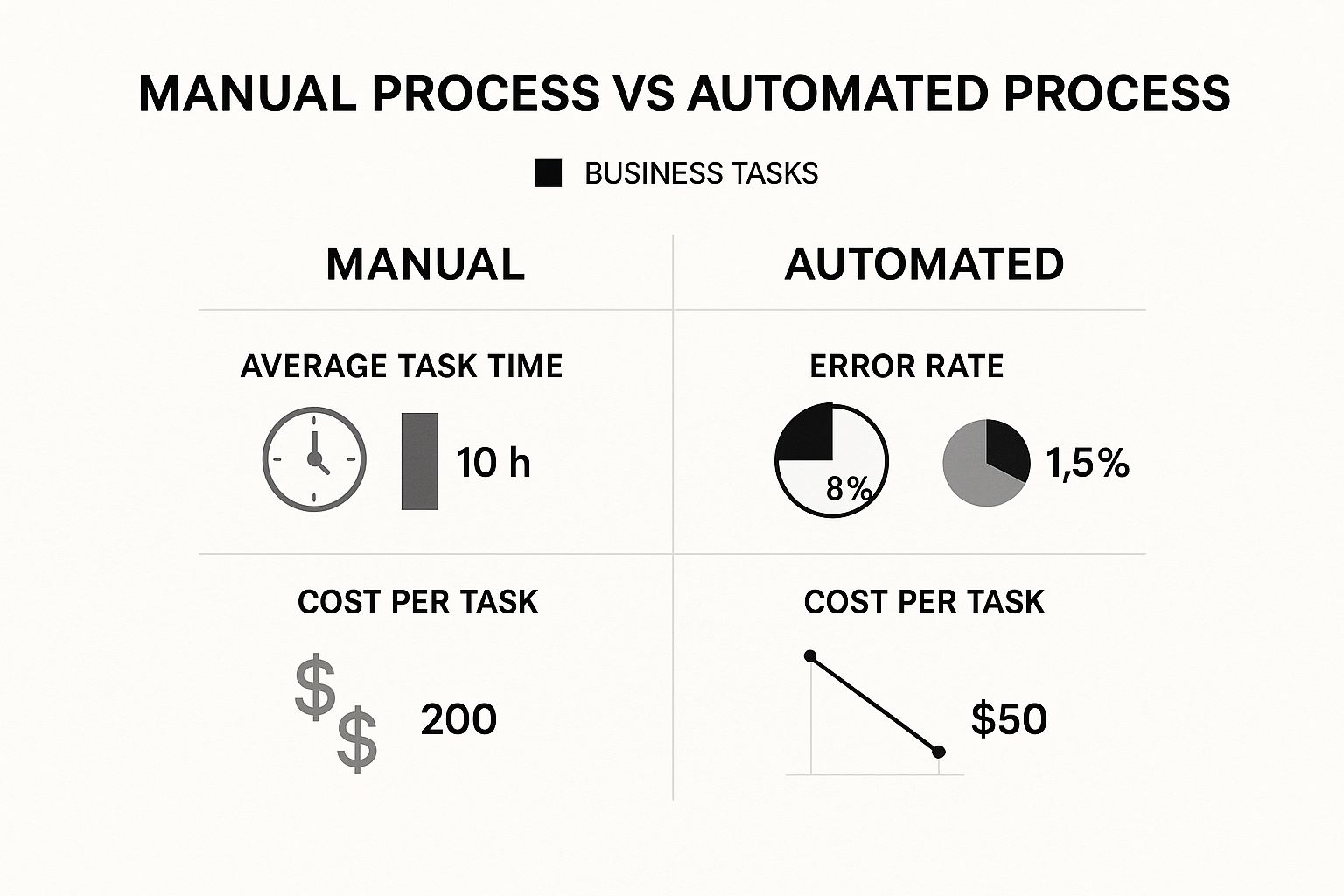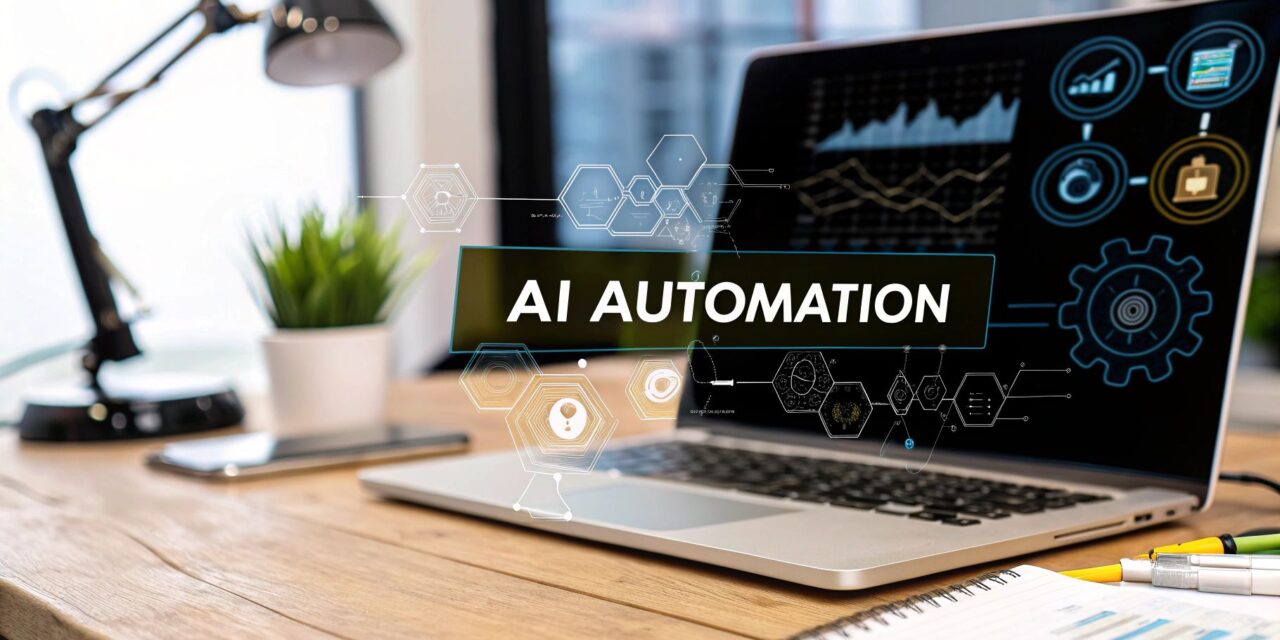Ever wish you could clone your best employees? AI automation is the next best thing. Think of it as giving your business a team of incredibly smart, fast, and tireless assistants. They'll happily handle the repetitive, time-consuming tasks—like sorting emails, crunching sales numbers, or answering the same customer questions over and over—so your team can focus on what they do best: thinking strategically, building relationships, and growing the business.
Your Guide to AI Automation in Business
If you're wondering how artificial intelligence can actually make a difference in your company, you've come to the right place. We're going to skip the jargon and get straight to the practical ways AI is becoming a must-have tool for businesses of every size, especially for folks who are just starting to explore this.
The whole point here is to break down the big ideas into simple, actionable concepts. Think of AI less as a scary, complex technology from a sci-fi movie and more as a strategic partner that can help you work smarter, not just harder. This shift is happening right now, and getting a handle on it is your ticket to staying ahead of the curve.
Why Is This Happening Now?
AI has officially moved from a "what if" conversation to a "what's next" reality for businesses. As of 2025, it’s clear that we've hit a tipping point. A massive 78% of global organizations are now using AI in some part of their operations. That’s a huge jump from just 55% the year before, which shows just how quickly this is taking hold.
So, what’s behind this sudden surge? It boils down to a few things:
- It’s finally accessible. AI tools are no longer just for massive corporations with huge budgets. They're more affordable and easier to use than ever.
- The results are real. Companies aren't just experimenting; they're seeing a clear return on their investment through better efficiency and lower costs.
- It's becoming a necessity. When your competitors start using AI to work faster and more effectively, you can't afford to get left behind.
"I talk to business owners every day, and the story is always the same," says tech consultant Maria Vance. "They see AI automation as the great equalizer. It gives small and medium-sized businesses the kind of operational power that was once reserved for the giants, leveling the playing field in a big way."
Understanding the Core Idea
So, what are we really talking about here? At its core, AI automation uses intelligent software that can learn, adapt, and even make decisions on its own. This is a world away from older automation, which could only follow a strict, pre-programmed set of "if-then" rules. For a more detailed look at the technology itself, our guide on understanding AI technology is a great starting point.
To help you get started, let's quickly define some of the key concepts you'll encounter.
Key AI Automation Concepts at a Glance
This table breaks down the fundamental building blocks of AI automation into simple terms, making it easier to grasp how these technologies come together.
| Concept | Simple Explanation | Business Analogy |
|---|---|---|
| Machine Learning (ML) | Teaching a computer to recognize patterns and make predictions from data, without being explicitly programmed. | An intern who gets better at sorting invoices by learning from past examples, eventually needing no supervision. |
| Natural Language Processing (NLP) | Giving computers the ability to understand, interpret, and generate human language—both written and spoken. | A customer service chatbot that can understand a customer's question and provide a helpful, human-like response. |
| Robotic Process Automation (RPA) | Using software "bots" to perform repetitive, rule-based digital tasks, like data entry or filling out forms. | A digital assembly line worker who perfectly copies and pastes information between spreadsheets 24/7 without errors. |
| Generative AI | A type of AI that can create brand new content, like text, images, or code, based on what it has learned. | A marketing assistant who can draft ten different versions of an email campaign in seconds for you to choose from. |
This guide is built for business leaders and curious professionals, not just data scientists. We're here to show you how AI is already adding real value and how you can start putting it to work, no matter how big or small your company is. Let's get started.
How AI Automation Changes the Game for Your Business
So, what does bringing AI automation into your business actually look like on a day-to-day basis? It’s not just about speeding things up; it's about getting smarter with how you work. Think of it as giving your team a toolkit of superpowers that eliminates the most tedious, error-prone, and soul-crushing parts of their jobs.
Take your sales team, for example. They might spend hours every week just logging call notes and updating customer profiles. Now, imagine an AI that transcribes their calls, pulls out the key action items, and updates your CRM automatically. This isn't some far-off future—it's a real-world shift that lets your best people do what they do best: building relationships and closing deals.
A Serious Boost in Efficiency
The first thing you’ll notice is a huge jump in efficiency. AI doesn’t need a coffee break, it never gets distracted, and it plows through repetitive tasks at a pace no human could ever sustain. This is where the initial transformation really hits home.
A perfect practical example? A marketing coordinator who used to burn an entire day pulling performance reports from a dozen different platforms. An AI tool can now do that in minutes. It grabs the data, arranges it into a clean dashboard, and can even point out important trends. Just like that, you've given that employee a full day back every week to focus on creative strategy instead of mind-numbing data entry.
This newfound efficiency has a direct impact on your bottom line. When your team can get more done in the same amount of time, you expand your capacity without having to expand your payroll.
Big Savings on the Bottom Line
More efficiency naturally leads to lower costs. When you automate tasks that once required a person's time, you cut down on the hours spent on administrative grunt work. This frees up both your people and your budget for things that actually generate revenue and move the business forward.
Let’s look at a practical example in the finance department. A small business might easily spend 10-15 hours a week just processing invoices, matching them to purchase orders, and chasing down late payments. An AI automation system can handle all of that instantly, cutting out costly human errors and reducing your operational overhead. The savings aren't just in wages; they're in avoiding mistakes like paying the same invoice twice or missing a critical payment deadline.
"The true power of AI automation isn't just in doing the old things faster, but in enabling businesses to do entirely new things," explains futurist Alex Chen. "When you free your team from the mundane, you unlock their capacity for innovation and strategic thinking—that's the real game-changer."
A Better Experience for Your Customers
It’s not just your internal team that benefits—your customers will feel the difference, too. We live in a world of instant gratification, and AI is one of the best ways to meet that expectation. It ensures your customers get quick, consistent, and genuinely helpful support, whenever they need it.
Here’s how AI automation elevates the customer experience:
- Always-On Support: AI-powered chatbots can handle common questions and solve simple problems around the clock, even when your office is closed. A customer with a question at 10 PM gets an immediate answer instead of having to wait until morning.
- Personalized Help: Modern AI can look at a customer’s past purchases and browsing history to offer them truly relevant recommendations or support. It makes people feel like you actually know who they are.
- Quicker Resolutions: For tricky issues, AI can act as the perfect assistant, gathering all the initial information before handing the customer off to the right human agent. This means no more frustrating transfers and no more repeating the same problem over and over.
When you improve your speed, personalization, and availability, you create happier customers who stick around longer. By transforming how you operate on the inside, you create a ripple effect that dramatically improves the customer's journey on the outside. This is how even small businesses can start delivering a level of service that was once reserved for massive corporations.
Seeing AI Automation in Action
Theory is great, but what does AI automation actually look like on the ground? It's easy to get lost in the buzzwords, so let's look at some real stories of how businesses are putting these tools to work. We're not talking about giant corporations with endless budgets, but everyday companies finding smart ways to solve common problems.
The real beauty of AI automation is its flexibility. It's not a one-size-fits-all solution. Instead, think of it as a toolkit that can be applied to almost any part of your business, from the front lines of customer service to the back-office tasks in finance and HR. The trick is to identify those time-consuming, rule-based jobs that keep your team from focusing on what really matters.
Real Stories from Real Businesses
Picture a small e-commerce store that sells handmade crafts. The owner used to spend hours every single day answering the same questions: "Where is my order?" "What's your return policy?" "Do you ship internationally?" It was a constant drain on her time.
By setting up a simple AI chatbot on her website, she now provides instant, 24/7 answers to all those common questions. The results were immediate. Customer satisfaction shot up because people got the help they needed right away, and sales even increased because the bot could gently guide shoppers to the right products. The owner now has several extra hours a day to do what only she can do—design new products and grow her business.
Or how about a local marketing agency? Their team used to burn half of every Monday just brainstorming and drafting social media posts for their clients. It was a creative grind. Now, they use a generative AI tool. They feed it a client's goals and a few key messages, and the AI generates a full week's worth of draft content in minutes.
The team still has the final say—they review, edit, and add their unique creative flair. But the heavy lifting is gone. This frees them up for higher-value strategic work, like diving into campaign analytics and building stronger client relationships.
This image really drives home the difference between a manual workflow and an automated one, showing just how much you can gain in time, cost, and accuracy.

The data doesn't lie. Automation isn’t about making tasks just a little bit faster; it fundamentally changes the resources required to get the job done.
Unlocking Value Across Departments
The power of AI automation isn't limited to customer-facing roles. Departments across the entire organization are finding clever ways to solve their own unique headaches.
To illustrate how AI automation can be applied across a company, let's look at some common tasks and the solutions that are transforming them.
AI Automation Use Cases by Business Function
| Business Function | Common Task | AI Automation Solution Example |
|---|---|---|
| Finance & Accounting | Invoice processing and data entry | AI-powered tools that scan invoices, extract key data (vendor, amount, date), and enter it into accounting software automatically. |
| Human Resources (HR) | Screening high volumes of resumes | AI platforms that scan applications for specific keywords, skills, and experience to shortlist the most qualified candidates. |
| Operations & Logistics | Optimizing delivery routes | AI systems that analyze traffic, weather, and delivery schedules in real-time to map out the most efficient routes for drivers. |
| Marketing | Content creation and social media management | Generative AI tools like Jasper or Copy.ai that draft blog posts, ad copy, and social media updates based on simple prompts. |
| Customer Service | Answering frequently asked questions | AI-powered chatbots like Intercom that provide instant, 24/7 support to customers on a website or app. |
| Sales | Lead qualification and email outreach | AI tools that analyze incoming leads to score their potential and automate personalized follow-up email sequences. |
This table shows that no matter which department you're in, there's likely a repetitive task that could be handled far more efficiently with the right automation tool.
It's important to note that while we're talking about AI, some of these examples use software "bots" that are programmed to handle very specific, rule-based tasks. If you're curious about that side of things, you can learn more about Robotic Process Automation and see how it fits into the bigger picture.
"The most successful businesses I see are the ones that start small," advises business process expert David Lee. "They don't try to automate everything at once. They pick one painful, repetitive process—like HR onboarding paperwork—and prove the value of AI there. That success creates momentum and gets the whole team excited about what's next."
The potential here is massive. Key sectors like IT and telecommunications are on the brink of huge advancements, with some projections showing AI could add $4.7 trillion in value to these industries by 2035. This isn't just hype; it's driven by AI’s proven ability to improve everything from network security to customer support.
Ultimately, these stories prove that AI automation is no longer some far-off, futuristic concept. It’s a practical, accessible solution that businesses are using right now to become more efficient, cut costs, and create better experiences for their customers and employees alike.
Your Roadmap to Implementing AI Automation

Alright, you’ve seen what AI automation for businesses can do. Now comes the big question: "Where in the world do I start?" It's a valid one, but the answer is simpler than you think. You don’t need a team of data scientists or a Silicon Valley budget to get going. The key is to be smart, start small, and let the small wins build on each other.
Think of this as your no-nonsense guide to getting AI up and running in your business. We're going to skip the jargon and focus on a practical process designed to get you a tangible victory right out of the gate.
Step 1: Start with the Right Task
The single biggest mistake companies make is trying to boil the ocean. They aim for some massive, complex problem right away, and they get completely bogged down. The real secret to success? Pick one small, high-impact task.
Look for a process in your business that is:
- Highly Repetitive: Think about the things your team does the exact same way every single day. We're talking about data entry, sending standardized follow-up emails, or sorting customer support tickets.
- Rule-Based: The job needs to follow a clear, logical set of steps. If you can write down the instructions for a human, an AI can probably handle it.
- Time-Consuming: Zero in on something that sucks up valuable hours each week. Automating that task will deliver an immediate, noticeable return.
A perfect practical example is manually pulling data from three different software systems to create a weekly sales report. It's a grind, it follows a set process, and it probably takes someone hours. That's your low-hanging fruit.
Step 2: Choose the Right Tools
Once you’ve got your target, it’s time to find the right tool for the job. The market is flooded with options, but you don't need the most expensive or powerful one. Focus on simplicity and how well it connects with your existing setup.
Look for tools famous for their user-friendly, "no-code" or "low-code" interfaces. This just means you can build automations with simple drag-and-drop actions instead of writing lines of code. Platforms like Zapier and Make are fantastic for this because they were built for business users, not developers.
"When you're evaluating a new tool, the most important question to ask is: 'Does this play nicely with my other software?'" says integration specialist Sarah Jenkins. "The best AI solutions connect seamlessly to the software you already use every day—your email, your CRM, your accounting software. A tool that just creates another data silo is a step backward."
Try to find tools that offer free trials or generous "freemium" plans. This lets you get your hands dirty and see if a platform actually works for your process before you spend a dime. It's the ultimate risk-free experiment.
Step 3: Prepare Your Team and Your Data
Bringing in new tech is just as much about people as it is about software. You have to get your team on board and make sure your data is ready for its new AI assistant.
Start by framing the change in a positive light. Make it clear that AI automation isn't about replacing people. It's about getting rid of the mind-numbing parts of their jobs so they can focus on more creative, strategic work. When your team sees AI as a helper that makes their day better, they'll be eager to adopt it.
Next, remember that data is the fuel for AI. For whatever task you chose, you need to make sure the information it will use is clean, organized, and consistent. If you’re automating invoice processing, for instance, make sure your invoices are saved in a standard format and location. A little data housekeeping now will save you from massive headaches later.
If you’re thinking about automating content, it’s crucial to have a solid brand voice guide and plenty of existing content for the AI to learn from. You can find some great examples of how data fuels these systems in our guide to the top AI tools for content creation.
Step 4: Measure Your Success
So, how do you know if it worked? You have to measure it. Before you even flip the switch on your new automation, define what a "win" actually looks like.
Here are a few simple metrics you should track:
- Time Saved: Calculate the raw number of hours your team gets back each week.
- Cost Reduction: If you were paying for overtime or outsourcing, track the direct cash savings.
- Error Reduction: Compare the number of mistakes made manually versus with the AI. Automation is often far more accurate.
- Speed of Execution: How much faster is the job getting done? A process that used to take a full day might now be over in minutes.
By tracking these straightforward numbers, you can easily prove the return on investment (ROI) of your first project. That success story becomes your best argument for getting buy-in to tackle your next, bigger AI automation goal.
Overcoming Common AI Automation Hurdles

It’s completely normal to have a few reservations when you're looking at bringing in new tech. Many business owners see the term AI automation for businesses and immediately start thinking about the price tag, the learning curve, or how it might shake things up for their team. These are all fair points, so let's get straight to it and tackle them with some practical, no-fluff answers.
First, let's clear the air on the biggest myth: that AI is coming for everyone's jobs. The real goal isn’t to replace people, but to give them superpowers. Think of AI as the ultimate assistant that handles the mind-numbing, repetitive tasks. This frees up your team’s brainpower for strategic thinking, creative problem-solving, and connecting with customers—the stuff humans are uniquely good at.
Addressing the Cost Concern
For most businesses, the budget is the first and biggest hurdle. There's a lingering idea that AI demands a massive, six-figure investment right out of the gate, but that's simply not true anymore. Today’s market is filled with affordable, pay-as-you-go tools that let you dip your toes in without breaking the bank.
You don't have to build a custom AI from the ground up. You can start by picking one tool that solves one specific, nagging problem. An AI chatbot for customer service, for instance, might have a manageable monthly fee but can save your support team dozens of hours every single week. The trick is to see it as a smart operational expense that pays for itself, not a giant capital investment.
Will My Team Rebel?
The fear of pushback from employees is very real. People naturally worry that new technology will make their hard-earned skills irrelevant. The key to getting this right is open communication and framing it as a move toward empowerment.
"The conversation should never be, 'This AI is taking over your tasks.' It should be, 'This tool is going to eliminate the boring parts of your job so you can focus on more important work.' When employees see AI as a personal assistant rather than a replacement, their entire perspective changes." — Angela Tran, Change Management Consultant
To make the transition smooth and get everyone on board, try these simple steps:
- Involve Your Team Early: Ask them straight up: "What's the most annoying, time-sucking part of your week?" They'll give you the best roadmap for where automation will have the biggest impact.
- Provide Simple, Focused Training: Don't just teach them how to use the tool. Show them how it makes their job easier and more enjoyable.
- Celebrate the Wins: When an automation frees up five hours that used to be spent on a tedious report, make a big deal out of it! This shows everyone that AI is a true partner in their success.
Navigating Data Security
Handing sensitive business information over to an AI system can definitely feel like a leap of faith. Data security is not something to be taken lightly—protecting your company and customer data is absolutely critical.
When you're looking at any AI tool, you have to dig into its security protocols. Ask direct questions. Look for platforms that are completely transparent about how they encrypt, store, and manage your data. Check for compliance with standards like GDPR or SOC 2. Any vendor worth their salt will have robust security measures and clear policies. A smart way to start is by automating processes with less sensitive data first, allowing you to build trust in the system before moving on to more critical operations.
What Comes Next for AI in Business
Looking ahead, the role of AI automation for businesses is shifting from being just another tool in the box to a genuine strategic partner. We're on the cusp of moving beyond automating simple, repetitive tasks and entering an era where AI is woven into the very fabric of creative thinking and long-range planning. The possibilities are genuinely exciting.
The pace of change has been nothing short of breathtaking. If you rewind to 2017, only about 20% of companies had dipped their toes into AI. Now? Over 300 million companies around the globe are either actively using or exploring AI automation. This isn't a slow burn; it's a wildfire, with markets like India seeing a nearly 59% adoption rate. This rapid uptake signals a deep, fundamental change in how we all do business. You can see the full story of this explosive growth on Exploding Topics.
Generative AI as a Strategic Partner
One of the most profound shifts on the horizon involves generative AI. Right now, a lot of businesses use it to knock out first drafts of emails or whip up a few social media posts. That’s useful, but it's just the beginning. The real game-changer is when it becomes a true brainstorming partner.
Picture this: you feed an AI all your quarterly sales data, a deep dive on your top competitors, and your biggest marketing goals. Then you simply ask it to outline three radically different strategies to grow your business. The AI could map out entire campaigns, forecast their likely impact, and even generate the initial creative briefs. In this scenario, AI transforms from a simple "doer" into a "thinker," helping you uncover angles and opportunities you might have otherwise overlooked.
"The future of AI in business isn't about replacing human creativity; it's about augmenting it," notes innovation expert Dr. Emily Carter. "We're entering a phase where AI will act as a co-pilot for strategists, providing data-driven inspiration that allows leaders to make bolder, smarter decisions faster than ever before."
The Rise of Hyper-Accessible AI
At the same time, AI tools are becoming radically more user-friendly and affordable. The days of needing a dedicated data science team and a six-figure budget just to get started are quickly fading. Instead, powerful AI features are being baked directly into the software you already rely on every day, whether it's your email provider or your accounting platform.
This "democratization" of AI is huge because it means even the smallest businesses can tap into incredible capabilities.
- Intuitive Interfaces: Forget coding. The best tools will continue to run on simple, natural language commands.
- Seamless Integration: AI will just work, humming quietly in the background of the apps you know and love.
- Affordable Pricing: Flexible subscription models are putting advanced AI within reach for virtually any budget.
The best way to prepare for this future is to start now, even if you begin with small, simple steps. By embracing AI automation for businesses today, you're not just improving efficiency—you're building a more resilient, innovative, and forward-thinking company for whatever comes next.
Got Questions About AI Automation? We’ve Got Answers.
Even after seeing all the benefits and real-world examples, it's completely normal to have a few questions swirling around. When you're thinking about a shift as big as bringing AI automation for businesses into your daily operations, you need to feel confident you have the full picture. Let's dig into some of the most common ones.
How Can a Small Business Dip Its Toes into AI Automation?
The best way to get started is to think small. Don't try to overhaul your entire company in a week. Instead, pinpoint one specific, repetitive task that eats up time and drives your team crazy.
Look for simple, ready-to-go AI tools that solve that one problem. Great starting points are often:
- Customer Service Chatbots: These can answer common questions on your website around the clock, freeing up your team.
- Social Media Schedulers: Many now use AI to help you write posts and schedule them for the best times.
- Email Marketing Platforms: Set up automated welcome sequences for new sign-ups without lifting a finger.
The beauty of these tools is that they’re built for people who aren't tech experts. Most don't require any coding, and many offer free trials, so you can see the impact of AI firsthand with virtually no risk.
How Do I Actually Measure the ROI of AI Automation?
Proving that your investment in AI is paying off is essential. The trick is to have clear "before and after" snapshots of your key metrics.
"The most powerful way to demonstrate AI's value is with simple, hard numbers," a seasoned CFO might advise. "Focus on things like 'hours saved per week' or 'percent reduction in errors.' Those are the results that get everyone's attention and justify expanding your efforts."
First, figure out your baseline. How are things running right now? Then, after you’ve had the AI tool running for a while, track the changes in a few key areas:
- Time Saved: How many hours of manual work is the AI taking off your team's plate?
- Cost Reduction: Are you cutting down on overtime pay or outsourcing costs?
- Revenue Growth: Is the automation helping you find more leads or convert customers more quickly?
And don't overlook the "softer" wins, like a noticeable drop in human error or a jump in team morale now that they're free from mind-numbing tasks.
Will My Team Need a Ton of Training to Use These AI Tools?
That’s a common worry, but the answer is usually no. It really depends on the complexity of the tool, but most modern AI platforms are designed with user-friendliness in mind. That said, a little bit of smart training can make all the difference.
Your training shouldn't be a boring technical manual. Instead, focus on showing your team exactly how this new tool makes their job better and easier. Frame the AI as a helpful assistant, not a replacement. Once your team sees it as a partner that helps them get more done, they’ll be eager to jump on board.
Ready to go from curious to confident? At YourAI2Day, we cut through the noise to bring you the latest news, tools, and insights that matter in the world of AI. Explore our resources and join a community of forward-thinkers at https://www.yourai2day.com.





